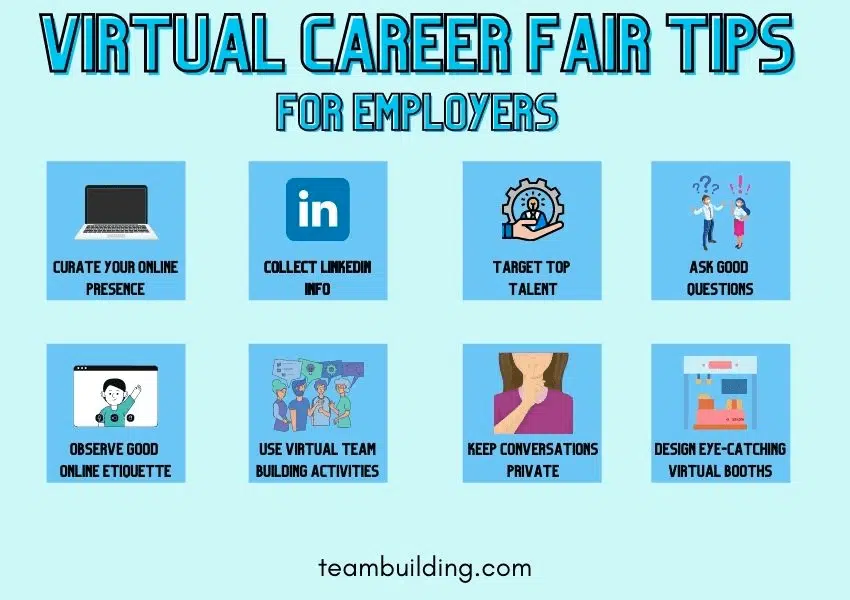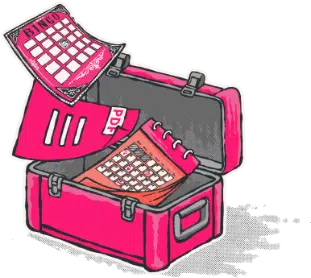You found our list of smart virtual career fair tips for employers and hosting organizations.
Virtual career fairs are recruitment-focused online events. The purpose of these events is for employers to attract and engage potential candidates. These events are also known as “virtual job fairs” and “digital recruitment events.”
These career fairs may be part of an online conference and benefit from the best applicant tracking systems. You can also read virtual event planning tips for advice on how to run these evetns.
This post contains:
- virtual career fair platforms
- virtual career fair best practices
- how to host a virtual job fair
Let’s get to it!
List of virtual career fair tips

Here is a list of best practices for online career fairs to make good impressions and attract ideal candidates.
1. Curate the company’s online presence
Candidates driven enough to attend online job fairs are likely to research participating employers. Be sure to curate the company’s online presence to attract the right sort of attention. At minimum, update job listings to reflect current openings. However, if you anticipate a hiring push in certain areas in the near future, feel free to hint at growth with lines like, “always looking for talented engineers and developers,” or “lots of opportunity as our marketing department expands.”
You should also maximize your social media presence, by promoting company culture, profiling employees or interns in in-demand departments, or highlighting recent organizational accomplishments.
Also, perform search engine queries to find out what information applicants see when researching the company, to better manage brand image and field candidate questions.
2. Collect LinkedIn profiles at registration
One of the major virtual career fair benefits is a streamlined registration and attendance process.
By collecting LinkedIn profiles at sign-up time, you enable recruiters to track applicants before and after the job fair. Researching candidates ahead of time allows you to target top talent. Compiling a database of LinkedIn profiles helps to maintain connections post-event. Not to mention, you can discover comparable candidates by using the “people also viewed” tool.
If you partner with a hosting platform that does not automatically collect LinkedIn URLs, then solicit them yourself by dropping a form into the chatbox. This exchange is also a great way for attendees to network with each other.
Get our free team building toolbox
- icebreaker games
- bingo cards
- DIY guides
 by teams at FedEx, Amazon, Deloitte and 73,930+ others
by teams at FedEx, Amazon, Deloitte and 73,930+ others

3. Target top talent early in the day
Career fairs can be a slog, even when attending from the comfort of the couch. Candidates will be at their freshest and most attentive in the morning. Companies are more likely to make an impression in the early hours of the event when attendees still possess a comparatively blank slate. If possible, survey the list of registrants and message promising applicants with invitations to earlier events. This approach deters the much-dreaded Zoom fatigue.
Of course, schedule conflicts might prevent you from grabbing applicants’ immediate attention. Getting the first word might give you the advantage, but starting a conversation at all is progress. Initiating contact puts you on a candidate’s radar and increases the likelihood that they will connect and explore your company.
However, do not limit options to standout profiles and invitees. Candidates are likely to surprise you throughout the event, so keep an open mind!
4. Think beyond common interview questions
Video interviews are a large component of virtual career fairs. Keep in mind that when participating in an online job fair with multiple organizations, your interview will be one of dozens or even hundreds. Even if your organization coordinates a solo event, candidates will likely attend other online job fairs. Interview fatigue and Zoom fatigue are real.
Yet with proper preparation and creativity, interviews offer an opportunity to capture candidate attention. To stand out from other employers, ask memorable questions.
Examples of challenging, insightful, or fun questions to ask during interviews include:
- If we hired you as CEO of this company tomorrow, what is the first change you would make?
- What is one fact you refrain from adding to your resume, but would love to include?
- You ask for $5,000 to solve a problem, but upper management only allocates $1,000 for your solution. What is your plan of attack?
- What is your strategy for surviving a zombie apocalypse?
Of course, to gather vital information, you will still need to ask common questions such as, “tell me about yourself,” or “what is your greatest work achievement.” However, pairing the basic questions with interesting inquiries reveals more about candidates and helps both parties better remember the interview.
For more inspiration, check out our list of the best interview questions.
5. Observe candidate etiquette standards
Interviews are a two-way street; recruiters need to dazzle talented applicants just as much as candidates need to impress potential employers. This reality means that many virtual career fair tips for employers and employees are the same.
Namely:
- Dress professionally, and touch up your appearance as needed.
- Broadcast from a clean, quiet, and distraction-free environment. Use tasteful virtual backgrounds if necessary, but keep your real backdrop tidy just in case.
- Test technology the day before the fair and fifteen minutes before the first meeting.
- Employ confident verbal communication and body language, practicing questions and answers before the call.
- Simulate eye contact by staring into the camera
- Avoid multitasking, and keep an uncluttered desktop in case you need to share your screen.
Following these guidelines demonstrates professionalism and respect, earning candidate appreciation and admiration and keeping your company in the running for top talent.
For more information, check out our article on virtual meeting etiquette.
6. Incorporate online team building activities into the interview process
In-person group interviews sometimes use team building exercises to test candidates’ cooperation skills. Virtual job fairs often involve multiple candidates chatting or asking recruiters questions in Zoom rooms at once. Seizing on this setup, divide participants into small teams and introduce a short online team building game, such as a typing race, quick draw, or a riddle or puzzle.
Then, observe how candidates interact with each other while completing the challenge. If you use breakout rooms, then send a company representative to participate in each one.
For more ideas, check out this list of online team building activities and this list of Zoom games.
7. Never discuss candidates in eaves-droppable areas
When attending the event with colleagues, you and your teammates will want to swap notes. Before comparing impressions, be sure the room is secure. Always double check that your microphone is on mute before speaking to nearby colleagues, lest you make a Zoom faux pas. Also, consider that if the room is not passcode protected, then new participants may be able to join mid-conversation. Overhearing comments on another candidate does not make a positive first impression. Be wary, too, of the platform’s chat feature. Ensure that you use a private messaging feature instead of writing in the chatbox where any guest can read.
For best results, compare notes post-event, or use an entirely separate communication platform to discuss candidates.
8. Craft a creative virtual career fair booth
Some virtual career fairs rely entirely on virtual conference platforms like Zoom, WebEx, or Microsoft Teams. Other events use platforms like Handshake to enable companies to create virtual meeting booths where employers and attendees can connect.
Crafting an engaging virtual booth helps organizations appeal to candidates and distinguishes the company from other employers.
Here are a few good virtual career fair booth ideas:
- Provide links to the online application, company website and social media channels. Consider condensing links into a single webpage or link tree.
- Play short recruitment videos to pique interest.
- Distribute digital swag like phone and desktop wallpapers, video game skins, trial subscriptions, apps, podcasts, ebooks, templates, or special offers. Or, collect physical addresses and send promising candidates physical swag and a short handwritten note.
- Incorporate virtual reality or augmented reality elements. For example, create an interactive custom photo booth feature.
- Offer virtual company tours and experiences.
The virtual career fair platform you use dictates the style or limitations of your booth. Some systems provide templates, so that your booth follows a standard format. Even so, ingenuity and creativity helps your company stand out from the crowd. Employing a distinct copywriting voice, a unique graphic aesthetic, or innovative ideas makes your digital presence more memorable.
How to host a virtual career fair

Here are the steps to hosting a successful online job fair that sparks interest, advertises company culture, and widens the talent pool. Play your cards right, and the event might end with a few offers!
Step #1: Designate a budget, date, and goals
The first step to planning any event is to set parameters. Determining a budget will inform further decisions, including whether to host your own job fair or join an existing event.
Picking a date is an equally important choice. Try to avoid college exam season, as well as conflicts with major industry competitors.
Once you settle these details, outline goals for the event. Understanding clear objectives will help you plan, perform, and measure results more effectively.
Step #2: Recruit an event execution team
Throwing an event requires a team, even if the venue is online. Gather a planning committee and event staff to help you design and execute the event. At minimum, you will need recruiters, designers, marketers, and of course, an IT team!
Step #3: Choose a virtual career fair platform
If you join an existing digital job fair, then a standardized structure will probably already be in place. If you design the event from scratch, then you will need to decide on an online career fair platform.
Here are a few good virtual career fair platforms:
- Paradox
- Gr8 People
- Hopin
- Handshake
- eightfold
- Brazen
- XOR
- Symplicity
- CareerEco
- 6Connex
Having an idea of your key components will steer you towards the best option. Some companies eschew a software structure in favor of online meeting platforms like Zoom, GoogleMeet, or Skype. Decide which method best suits your needs, then research choices and select your tools.
Step #4: Plan your online program
After nailing down basics, focus on event flow. There are several ways to structure the fair. Some organizers prefer a straightforward meet-and-greet and interview format. Other planners opt for more robust agendas filled with events such as question and answer sessions, talks, networking chats, games, and even entertainment. Since recruitment is the main purpose of the occasion, prioritize candidate contact, but remember to schedule breaks to refocus and regain stamina, and consider adding diverse offerings that may boost participation.
Here is a list of online engagement ideas.
Step #5: Design your digital booths
An engaging and aesthetically pleasing virtual booth attracts attention. Consulting your art or graphic design department is a smart move. Art and marketing professionals should have some hand in the booth creation, even if you need to outsource. Using multimedia elements like video, virtual reality, links, and apps offers a multifaceted approach to enticing visitors. Brainstorming out of the box ideas, such as offering creative digital swag, provides further incentive for attendees to check out your company.
You can learn more about design in online art classes.
Step #6: Promote the event
Virtual career fairs enable a more geographically and culturally diverse pool of applicants to attend, but only if those potential guests are aware of the event! Promotion is one of the most important components of a successful online job fair.
Be sure to touch base with the marketing team to agree on a plan. The best bet is to promote on multiple channels, such as:
- Company website
- Social media
- Professional organizations and groups
- Industry-specific media
- Colleges and universities
- Email campaigns and newsletters
- Event websites
Not every advertising avenue might be ideal for your occasion, so determine which channels promise optimal impact. Then, pick the most appropriate ways to spread the word.
Step #7: Monitor registrations
Once you open signups, keep tabs on registrants to better estimate attendance and prepare accordingly. Scanning the guest list also enables you to reach out proactively to candidates and invite them to visit the booth or schedule an interview. Plus, you can more effectively strategize ways to capture your audience’s attention.
Step #8: Host the online career fair
Be sure to test all technology in the week leading up to the event, and then again on the morning of. When the day arrives, follow the event agenda. Enjoy the fruits of your efforts, and bask in the presence of bright, eager perspectives. To stave off Zoom fatigue, give yourself breaks between sessions. The day may seem daunting while meetings occur, but at the end of the event you will have a list of promising leads, and perhaps even a few new employees!
Step #9: Follow up with promising connections
Businesses often put the onus of next steps on applicants. You can follow up post-event to keep leads warm and maintain an applicant pipeline, leading to a larger return on investment in the long run.
At minimum, send thank-you emails to attendees. If there are any upcoming virtual happenings, such as webinars or brand events, consider extending an invitation so that you can continue developing rapport.
Be sure to connect with promising candidates on LinkedIn, and encourage guests to follow the company on social channels. You may meet a strong candidate that is not a match for current openings, but may fit a future need. Plus, social media networking gives organizations access to individual’s networks. A reshare or virtual referral may lead you to more talent.
Final Thoughts
Virtual job fairs are a great alternative to traditional recruiting events. Online recruiting events enable candidates from across the country, or even the globe, to attend. This aspect means you connect with a wider audience and have the opportunity to promote your organization on a larger stage.
Not to mention, electronic job fairs are typically more financially conservative and hassle-free endeavors compared to in-person events. By following the tips on this list, you are sure to run a great show and mingle with a number of promising prospects, all without leaving your home turf!
Next, check out our list of ideas for virtual orientation week and this guide to virtual graduations.
You may also want to consult books on recruiting, career books, and this list of virtual interview tips.




